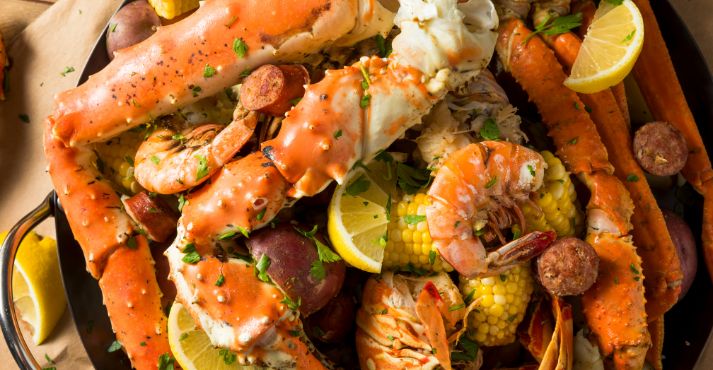In today’s era of growing sustainability consciousness and ethical dietary preferences, the demand for eco-friendly food choices has led to the emergence of plant-based seafood.
This article will define plant-based seafood, explore its core ingredients, examine innovative production methods, and shed light on its crucial role in advancing sustainable and compassionate dining options.
Defining Plant-Based Seafood

Plant-based seafood is designed to taste, feel, and look like traditional seafood, such as fish and shrimp. However, what makes it unique is that it’s entirely made from plant-based ingredients.
These innovative products are often called vegan seafood because they capture the essence of oceanic flavors without using any fish or marine animals. Instead, they use a clever mix of plant-based elements to replicate seafood’s delicious taste and texture.
This development is part of a more significant movement towards sustainable and ethical eating, where people are looking for tasty alternatives that don’t harm our oceans or marine life.
Plant-based seafood is becoming increasingly popular as it aligns with these values while satisfying our seafood cravings.
Ingredients and Production
Plant-based seafood production involves carefully selected ingredients and intricate processes to recreate the flavors and textures of traditional seafood. Let’s delve into the core components and production methods:
Ingredients Used
Plant-based seafood relies on a variety of natural ingredients. Algae, seaweed, legumes, and a range of plant-based proteins are the building blocks of these innovative products.
These ingredients are thoughtfully chosen for their ability to mimic the taste and texture of seafood while maintaining a sustainable and ethical approach to food production.

Algae: Algae are a vital ingredient in plant-based seafood. They provide a natural seafood-like flavor and contribute to the oceanic aroma associated with traditional seafood dishes.
Seaweed: With its unique texture and umami taste, Seaweed plays a crucial role in replicating the mouthfeel and oceanic essence of seafood.
Plant-Based Proteins: Legumes and other plant-based protein sources, like soy or wheat, create the desired texture. They are processed for flakiness and tenderness in fish and other seafood products.
Next, we’ll explore how these elements come together through specific production methods.
Production Methods
Intricate production methods are employed to craft plant-based seafood that captures the essence of traditional seafood. Let’s dive into these processes:
Extrusion: Food extrusion is a fundamental step in plant-based seafood production. This technique involves passing a mixture of plant-based ingredients through specialized machinery. The mixture becomes a seafood-like texture as it undergoes high pressure and temperature. Extrusion reduces flakiness and tenderness in fish fillets and other seafood products.
Flavoring: Flavoring is another pivotal aspect of plant-based seafood production. To recreate the distinct taste of various seafood options, flavorings are derived from plants and meticulously selected herbs and spices. These natural flavorings are expertly combined with the base ingredients to achieve an authentic seafood taste that satisfies even the most discerning palates.
Shaping: Shaping is the final touch in the production process. It ensures that plant-based seafood products resemble their traditional counterparts in appearance. Careful shaping creates the familiar look of fish fillets, shrimp, or scallops, making these alternatives visually appealing and delicious.
Types of Plant-Based Seafood
Fish Fillets and Shrimp
Plant-based fish fillets and shrimp have gained immense popularity for their uncanny resemblance to traditional seafood.
These vegan alternatives closely mimic their oceanic counterparts’ taste, texture, and versatility. They have found their way into a plethora of recipes, catering to the preferences of both vegans and environmentally conscious consumers.
Fish Fillets:

Plant-based fish fillets offer a delightful and sustainable alternative to traditional fish. Crafted to emulate the flakiness and tenderness of fish, they are suitable for a wide range of dishes.
Whether pan-fried, baked, or grilled, these fillets maintain their structure and savory flavor.
Vegan Shrimp:
Plant-based shrimp are another standout in the world of seafood alternatives. They capture the succulent and slightly sweet essence of traditional shrimp.
Whether used in pasta, stir-fries, or as a delightful appetizer, vegan shrimp provide a guilt-free indulgence.
Scallops and Crab Cakes
Plant-Based Scallops:

Plant-based scallops offer an exciting alternative to their seafood counterparts. Crafted with precision, they replicate traditional scallops’ tender texture and mild flavor.
These versatile morsels can be seared to perfection and used in various dishes, from elegant seafood pasta to savory stir-fries.
Vegan Crab Cakes:
Plant-based crab cakes are a culinary delight for those who relish the taste of crab without the ethical dilemmas.
These flavorful cakes are typically made from a combination of plant-based proteins, seasonings, and binding agents that replicate the texture and taste of crab. They’re perfect for crab cake sandwiches, salads or enjoyed as appetizers.
Benefits of Plant-Based Seafood
Environmental Sustainability
Plant-based seafood offers a ray of hope for our oceans and the delicate ecosystems within them. This section will explore how these innovative alternatives contribute to environmental sustainability by addressing overfishing, bycatch and protecting our oceans.
Reduced Overfishing

Traditional fishing practices, driven by the global demand for seafood, have led to overfishing that is pushing marine species to the brink of extinction.
This unsustainable approach not only endangers aquatic life but disrupts the balance of our oceans.
Plant-based seafood offers a sustainable solution by eliminating the need for large-scale fishing operations. As a result, it reduces the pressure on our oceans and allows marine populations to recover.
Lower Impact on Oceans
The production of plant-based seafood has a significantly lower impact on our oceans than traditional fishing methods. It doesn’t require vast trawler fleets scouring the seas, which can unintentionally capture and harm non-target species.
Instead, it relies on responsible sourcing of plant-based ingredients, reducing habitat destruction and minimizing the adverse effects on marine ecosystems.
Decreased Bycatch
One of the most devastating consequences of commercial fishing is bycatch – the unintended capture of non-target species.
Bycatch often includes dolphins, sea turtles, and other marine animals, many of which are threatened or endangered.
Plant-based seafood production eliminates this issue, as it doesn’t involve indiscriminate fishing practices. This significantly reduces harm to non-target species, promoting biodiversity and protecting fragile marine ecosystems.
Health Benefits
Plant-based seafood offers many health benefits, making it an attractive choice for many consumers. These advantages increase popularity among those seeking a healthier diet and lifestyle.
One significant health benefit of plant-based seafood is its low mercury content. Unlike some traditional seafood, which may contain elevated levels of mercury due to environmental pollution, plant-based seafood is mercury-free.
This absence of mercury makes it a safe and worry-free choice for individuals concerned about heavy metal exposure.
Additionally, plant-based seafood is often free from contaminants and ocean pollutants. This is particularly important for those who wish to minimize their intake of harmful substances sometimes associated with conventional seafood.
By choosing plant-based alternatives, consumers can reduce their exposure to contaminants and enjoy a cleaner, more wholesome diet.
Moreover, plant-based seafood can be a valuable component of a healthy diet. It provides essential nutrients like protein, vitamins, and minerals without the concerns associated with traditional seafood, such as overfishing or the impact on marine ecosystems.
These nutrients support overall health and well-being, making plant-based seafood an excellent choice for individuals looking to maintain a balanced and nutritious diet.
Considerations and Challenges
Taste and Texture of Plant-Based Seafood:
Plant-based seafood products aim to replicate the taste and texture of traditional seafood while offering a sustainable and ethical alternative. Achieving the perfect balance between taste and texture is crucial for consumer acceptance.
Advancements in Technology:
Recent technological innovations have played a pivotal role in enhancing the taste and texture of plant-based seafood. These advancements include:
Flavor Precision: Food scientists and flavor experts have developed precise methods to recreate the unique tastes of various seafood, such as fish umami or oysters’ saltiness. This involves the use of natural flavorings derived from plants and microorganisms.
Texture Mimicry: Texture is another critical aspect. Researchers have been able to mimic the flakiness of fish fillets or the tenderness of shrimp by carefully selecting plant-based ingredients and optimizing processing techniques. Extrusion and 3D printing are among the methods used to achieve realistic textures.
Sensory Feedback: Advanced sensory analysis techniques, including instrumental and sensory panel evaluations, are employed to fine-tune the sensory attributes of plant-based seafood. This helps align the products more closely with the sensory experiences of traditional seafood.
Challenges in Plant-Based Seafood:
Despite significant progress, several challenges persist in perfecting the taste and texture of plant-based seafood:
Sustainability and Sourcing: Sourcing sustainable plant-based ingredients can be challenging, and the availability of specific ingredients can vary seasonally, affecting product consistency.
Allergen Concerns: As with any food product, addressing allergen concerns is essential. Manufacturers must ensure that plant-based seafood products are free from common allergens and adequately labeled.
Culinary Adaptability: Plant-based seafood should be versatile enough for various culinary applications. Adapting to different cooking methods while maintaining taste and texture can be complex.
Allergen Concerns in Plant-Based Seafood
Plant-based seafood products are designed to mimic the taste and texture of traditional seafood while offering a sustainable and ethical choice.
However, addressing potential allergen concerns is crucial, as some ingredients commonly used in these products can be allergenic. Two common allergens associated with plant-based seafood are seaweed and soy.
Seaweed Allergy

Seaweed is a primary ingredient in many plant-based seafood products, as it often provides the oceanic flavor and umami associated with seafood.
While seaweed allergies are relatively rare, they can occur. Symptoms of seaweed allergy may include skin rash, itching, swelling, or digestive discomfort.
Soy Sensitivity
Soy is another common ingredient in plant-based seafood, particularly in products mimicking fish or shrimp.
Soy allergies are more prevalent, and individuals with soy sensitivity must exercise caution when consuming plant-based seafood containing soy-based ingredients. Symptoms of soy allergy can range from mild hives to severe anaphylaxis.
Addressing Allergen Concerns
For individuals with food allergies or sensitivities, it’s essential to take the following precautions when considering plant-based seafood options:
- Read Labels: Always read product labels carefully. Manufacturers must list potential allergens, making it easier for consumers to identify products that may pose a risk.
- Contact Manufacturers: If you have specific allergen concerns, consider contacting manufacturers for detailed information about their ingredients and processing methods. Some companies may provide allergen-specific guidance.
- Allergist Consultation: Individuals with severe allergies should consult an allergist or healthcare professional before trying new plant-based seafood products. They can provide personalized guidance and recommend safe alternatives.
- Cross-Contamination: Be aware of the risk of cross-contamination. Even if a plant-based seafood product does not contain a particular allergen, it may have been processed in facilities that handle allergenic ingredients.
- Homemade Options: Consider preparing plant-based seafood dishes at home using allergen-free ingredients to have better control over allergen exposure.
The Future of Plant-Based Seafood
As we look to the future, the prospects for plant-based seafood appear promising, with several exciting developments on the horizon. Let’s delve into what the future may hold for this burgeoning industry:
- Expanding Market Share: Plant-based seafood is expected to gain a larger market share as consumers seek sustainable and ethical alternatives to traditional seafood. As awareness of the environmental impact of overfishing and the benefits of plant-based options grows, we can anticipate an increasing demand for these products.
- Innovation and New Products: The plant-based seafood industry is ripe for innovation. Companies are continually working on perfecting their products and expanding their offerings. We expect to see a wider variety of plant-based seafood products, including new flavors, textures, and forms that closely mimic traditional seafood.
- Sustainability in Focus: Plant-based seafood aligns with the growing sustainability trend in the food industry. It contributes to reduced pressure on our oceans, mitigates overfishing, and decreases the environmental footprint associated with traditional seafood production. As sustainability becomes a top priority for consumers, plant-based seafood will likely play an increasingly significant role in shaping more ethical and eco-conscious food systems.
- Culinary Creativity: Chefs and culinary experts are exploring the creative possibilities of plant-based seafood in their kitchens. This experimentation with plant-based ingredients results in innovative and delicious seafood-inspired dishes catering to plant-based and omnivorous consumers.
In summary, the future of plant-based seafood looks bright, with growth potential, innovation, sustainability, and culinary creativity at its core.
As consumers become more conscientious about their food choices, plant-based seafood is poised to contribute to sustainable and ethical food systems substantially.
Conclusion
In conclusion, plant-based seafood offers a sustainable and ethical choice for consumers. It meets the demands of health-conscious individuals and those concerned about the environment.
With its potential to reshape the food industry, plant-based seafood paves the way for a more compassionate and sustainable future.













